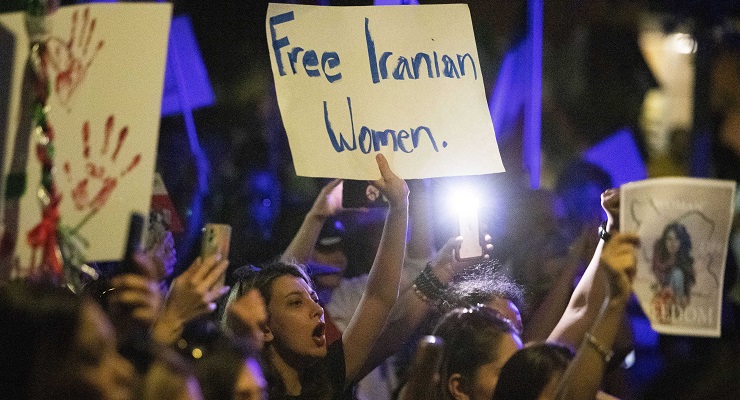
Since mid-September, protests have swept across Iran, the world and the internet after 22-year-old Mahsa Amini died while in the custody of Iran’s morality police for allegedly violating the country’s dress code and wearing her hijab too loosely.
While the police and government claim Amini died of heart failure due to an underlying health condition, her family says this is false and alleges she was beaten while in custody.
Protests began in Tehran but quickly spread to more than 80 cities across the country and then further afield. They’ve lasted more than two weeks and represent the most serious challenge to the Islamic Republic and its theocratic leaders in a decade — and they’re been led by young women.
Gen Z women use social media to amplify their message
Iran is no stranger to protests. In 2009 protesters of the Green Movement demanded the removal of Mahmoud Ahmadinejad from office after what many believed was a fraudulent presidential election. A decade later, in 2019, a nationwide civil protest took off. Initially caused by a huge rise in fuel prices, it again led to calls to overthrow the government and Supreme Leader Ali Khamenei. The government shut down the internet for six days during these protests, resulting in a near-blackout of information in and out of the country.
But in 2022 the government can’t control the internet as much as it once could, and a new generation of women are using it to make sure they’re heard.
To be clear, the focal point of these protests is the street — women are going out in public, tearing off their hijabs, burning them, and cutting their hair off in open opposition to the mandatory dress code that requires all women to wear headscarves and loose-fitting clothes in public — but via social media, the world watches.
What these women are doing is extremely dangerous. In normal times, flouting the dress code can result in fines, prison or flogging — during these protests, already more than 80 people have been killed in the police crackdown. Again, a lot of the victims are young women.
But even those who aren’t taking to the street are still joining the protests. Search “Mahsa Amini” or “Iran protests” on TikTok and your feed will be awash with videos of women removing their hijab and cutting their hair onscreen in solidarity with those out in the streets. It’s a visually powerful message, and it’s being shared and copied widely.
Although the Iranian government has repeatedly shut down mobile internet connections and disrupted the services of Instagram and WhatsApp, it hasn’t seemed to have stopped protesters’ images and messages from spreading.
Why? Because those at the forefront of these protests know the power of the internet. Digital natives, they’re used to using social media to express their views in a global space. And when the first protests began and they knew an internet crackdown was imminent, they also knew their government didn’t have the power to shut down their message if the rest of the world picked up the fight. So as well as frequently managing to evade internet crackdowns, they also asked others to share and amplify their posts using the hashtag #BeOurVoice.
While the act of jumping on to a social movement from a safe and privileged place such as Australia is often derided as “slacktivism”, in the case of the Iran protests it’s been an invaluable resource as celebrities and regular users reshare messages of resistance.
Youth-led social movements are a powerful force
Recent history tells us that young people who use the powers of global social media are a powerful force. From the Arab Spring, organised in the early days of Twitter, to the global climate movement spurred by youth activists connecting and amplifying their message online, social media has been a key tool for huge youth-led social movements.
Iranian schoolgirls know this. 17-year-old Nika Shakarami vanished during the protests and her body was handed back to her family days later with her nose smashed and her skull pounded. Now, as teen girls mourn the death of Shakarami, videos are emerging of them joining the protests, tearing off their hijabs in school buildings before marching down the street.
The protesters’ rallying cry is “Women. Life. Freedom”. It’s adopted from Kurdish female fighters and now, when social media means that one country’s struggle can’t be contained by internet blackouts, it’s a cry that’s being heard around the world.








And do we stand with the persecuted women of Saudi Arabia? Nah. They’re brutal bastards but they’re on our side. We hate Iran so it’s fair game.
I am happy to stand with the persecuted women who are repressed by Islam or indeed any other oppressive social or religious order. I certainly do not regard the Saudis as being “on my side” in any way, shape or form.
Violence against women goes on all over the world. Its the nature of all patriarchies. The degree of barbarity depends on legal structures rather than men’s attitudes to women.
Just look at our own ‘ christian’ country. It took years to make rape in marriage a criminal offence…’sanctity of the marriage chamber’ courtesy of the church, was one argument. Husband’s immunity was another. The ‘ vindictive wife’ was prattled off in all media and agreed with wholeheartedly. The almost impossibility of proving it, via the law, is the best protection rapists have. Conservative women joined in the misogynistic hysteria.
It wasn’t until 2005 that ‘provocation’ as a defense to murder was abolished ( for killing a partner because she left.)…sounds awfully Saudi to me.Sexually harassing women out of their jobs continues apace. Even in the High Court and Parliament House. Christians still preach and demand wives be obedient to their husbands, despite the well known violence in so many of those marriages.
The message seems to be that women are meant to be breeding and doing what men want. Despite the rhetoric, the reality boils down to this. Even under Joe Biden, women are questioned as to whether they have had an abortion. Looking at the very high levels of domestic violence suggests a LOT of men in this country are no less barbaric The police moan that DV is the most common call out they get every day…one call every 2 minutes!
Like that retired Australian diplomat, unclear if registered as a ‘foreign agent’, promoting the Kremlin line at every opportunity?
By coincidence he let the cat out of the bag i.e. his preferred Anglo media is also preferred by conservative Christian GOP types and ageing alt right.
Is it a coincidence that many in US who avert their gaze from Saudi, not just Trumpers, also follow Kremlin agitprop, under the guise of ‘patriarchal conservative Christian values’?
Drew..you were 2 votes up yesterday but then the misogynists arrived and are down voting anyone who says anything in support of women. This nasty cabal proves feminists right 🙂
The Suadis are a mafia. They are on no ones side but their own.
We need more reporting on this issue please. I just saw something about thousands of protesters being sentenced to death. I’d like to know more about what is happening about this.
It’s been ongoing since the ’80s, but digital and ageing demographics have been used by authorities to develop and retain the status quo.
However, like elsewhere including US GOP and Russia, as more educated generations emerge authority and patriarchy are being challenged, but this can lead to calls for more draconian actions.
Women are so brave. They are completely powerless yet they have challenged these weak, violent men ( and their ‘laws’ dressed up as ordained by some mythical god/bogeyman they claim is real) all through the ages. I dips me lid to these Iranian women.Sickening to see such brutality in 2022. The USA is barely any different. It recently added another way to brutalise women with its abortion laws. The lord giveth and the lord taketh away.